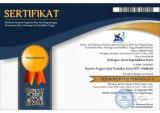Identification of Learning Theories in Learning Videos: A Case Study of Prospective Chemistry Teacher Students
DOI:
https://doi.org/10.33394/hjkk.v13i5.17500Abstract
This study investigates the ability of prospective chemistry teachers to identify learning theories embedded in instructional videos. A descriptive qualitative case study was conducted involving 48 students enrolled in the Foundations of Science Education course at Universitas Negeri Makassar. Three chemistry instructional videos were deliberately designed to incorporate elements of behaviorist, cognitivist, constructivist, humanistic, and cybernetic theories. Students analyzed the videos using an identification sheet to document their observations. The findings reveal varying levels of recognition across the learning theories. Constructivist theory was most frequently identified in Video 1, while behaviorist principles dominated Videos 2 and 3, particularly in segments emphasizing drill, repetition, and stimulus–response reinforcement. Cognitivist theory appeared consistently, though less prominently, across all videos. In contrast, humanistic and cybernetic perspectives were recognized to a lesser extent, suggesting that affective, motivational, and systemic components were less explicitly represented. These results underscore the importance of integrating diverse learning theories in video-based instruction to promote not only conceptual understanding but also motivation, empathy, and systemic thinking. The novelty of this research lies in positioning instructional videos as pedagogical representations that reveal prospective teachers’ reasoning about learning theories, rather than merely treating them as delivery tools. This approach provides a new lens for evaluating theoretical literacy in teacher education and emphasizes the need for reflective engagement with instructional media during teacher preparation.
Published
How to Cite
Issue
Section
Citation Check
License
License and Publishing Agreement
In submitting the manuscript to the journal, the authors certify that:
- They are authorized by their co-authors to enter into these arrangements.
- The work described has not been formally published before, except in the form of an abstract or as part of a published lecture, review, thesis, or overlay journal.
- That it is not under consideration for publication elsewhere,
- That its publication has been approved by all the author(s) and by the responsible authorities – tacitly or explicitly – of the institutes where the work has been carried out.
- They secure the right to reproduce any material that has already been published or copyrighted elsewhere.
- They agree to the following license and publishing agreement.
Copyright
Authors who publish with Hydrogen: Jurnal Kependidikan Kimia agree to the following terms:
- Authors retain copyright and grant the journal right of first publication with the work simultaneously licensed under a Creative Commons Attribution License (CC BY-SA 4.0) that allows others to share the work with an acknowledgment of the work's authorship and initial publication in this journal.Â
- Authors are able to enter into separate, additional contractual arrangements for the non-exclusive distribution of the journal's published version of the work (e.g., post it to an institutional repository or publish it in a book), with an acknowledgment of its initial publication in this journal.
- Authors are permitted and encouraged to post their work online (e.g., in institutional repositories or on their website) prior to and during the submission process, as it can lead to productive exchanges, as well as earlier and greater citation of published work.
Licensing for Data Publication
Hydrogen: Jurnal Kependidikan Kimia uses a variety of waivers and licenses, that are specifically designed for and appropriate for the treatment of data: Open Data Commons Attribution License, http://www.opendatacommons.org/licenses/by/1.0/ (default) Other data publishing licenses may be allowed as exceptions (subject to approval by the editor on a case-by-case basis) and should be justified with a written statement from the author, which will be published with the article.








